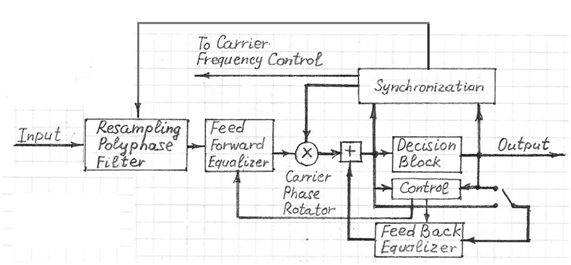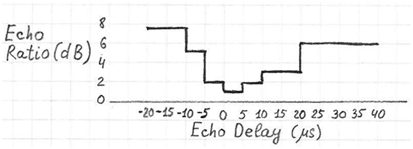ATSC Digital Terrestrial TV Receiver Equalizer must deal with the presence of multipath propagation for terrestrial TV broadcasting channels.

The direct path signal is the signal that propagates directly from the transmitter antenna to receiver antenna. The reflected signal is the signal that was received after reflection from different objects such as buildings, mountains, air planes, etc. All of these signals have different propagation times, and they are combined at the receiver’s antenna. This is equivalent to passing the original TV signal through a complex FIR filter.
A reflected signal is called an echo-signal. Usually the reflected signal comes to the receiver after the direct signal and is called a post echo. Sometimes the direct signal is not received and all received signals are from reflections. In this case, the strongest reflected signal is considered to be the main signal, and the rest are considered echo signals. An echo may also be received earlier than the main signaland is called a pre-echo.
Pre and post echoes may completely destroy the shape of the received symbols. This distortion must be corrected so a decision can be made on which symbols were received. The equalizer tries to correct these distortions. It consists of a feedforward equalizer, feedback equalizer, decision block, control block, synchronization block, carrier recovery phase rotator, and resampling polyphase filter. The feedforward equalizer corrects pre-echos, and the feedback equalizer corrects post-echos. The decision block makes decisions about the received symbols. The synchronization block estimates the frequency and phase errors of the carrier signal and the symbol timing frequency error. The resampling polyphase filter corrects the symbol timing frequency error. The carrier frequency error is corrected by the rotator located outside the equalizer. The carrier phase rotator corrects the carrier phase error. The control block modifies the feedforward and feedback equalizer coefficients based on a decision error minimization algorithm.
In the presence of severe multipath propagation error, the decision block is turned off to allow the equalizer to converge. First, the carrier frequency and timing have to recover. Then the feedforward and feedback equalizers do preliminary equalization. To do the final equalization, the decision block is turned on and the carrier phase is recovered.
The feedforward equalizer takes a lot of resources since its length must be several times longer than the corrected pre-echo delay. However, the length of the feedback equalizer, since it’s implemented as a loop, is equal to the corrected post-echo.

The performance of an equalizer can be characterized by plotting echo delay against the largest echo ratio the equalizer is able to handle at that delay. Signals falling above the line should be received properly, while signals falling below it may not be received.
More Information
- ATSC Digital Terrestrial TV Transmitter
- ATSC Digital Terrestrial TV Receiver
- ATSC Digital Terrestrial TV Modulator
- Video Codecs
- Video Design
- Video Reference Designs